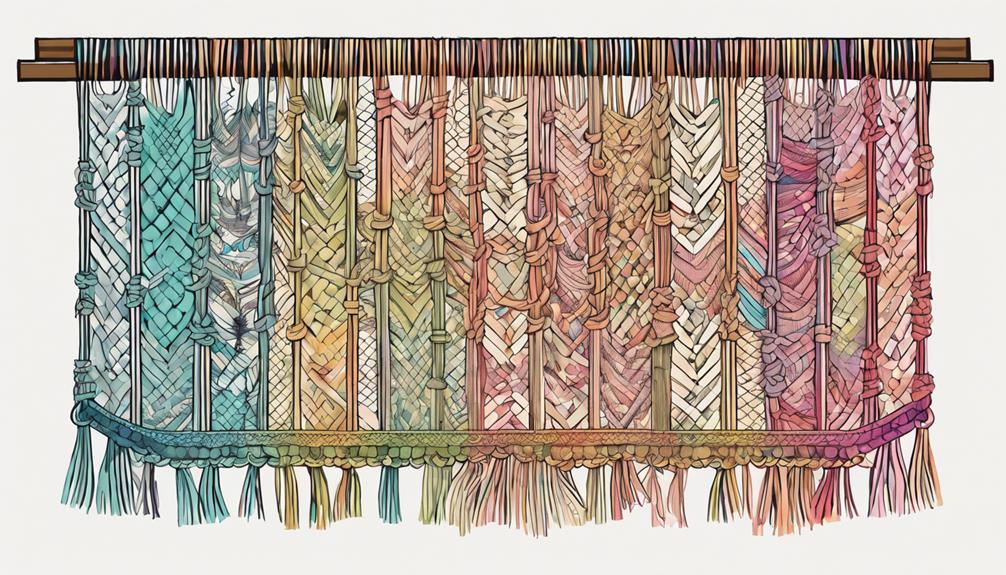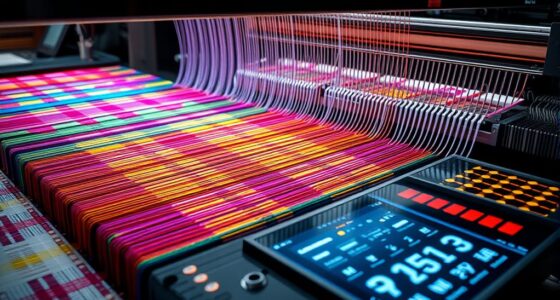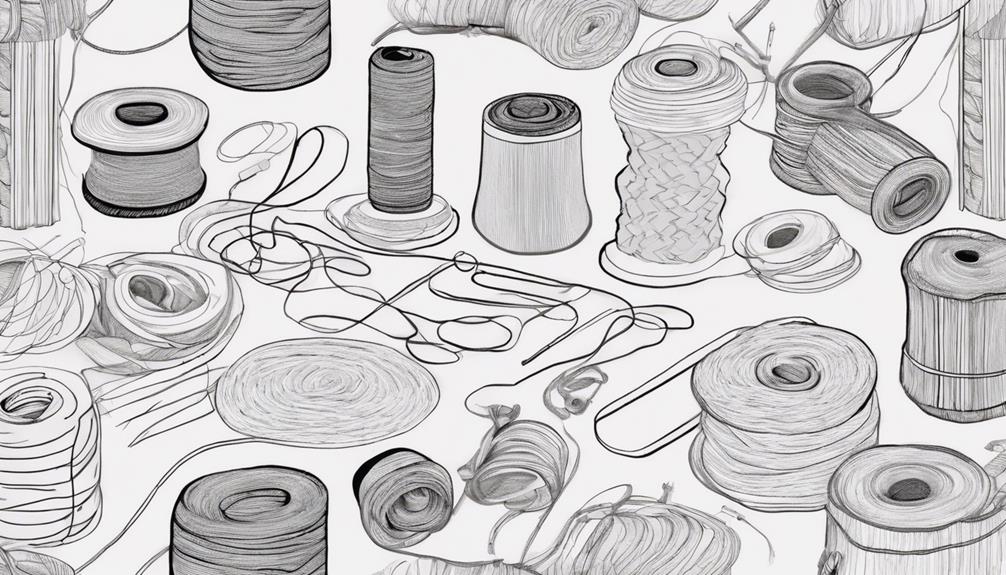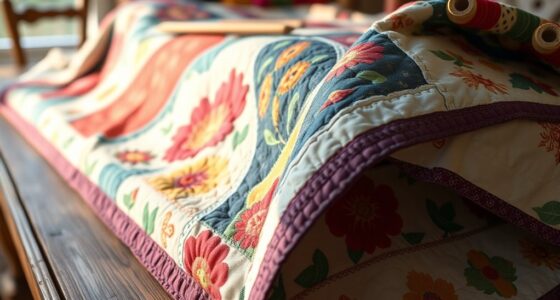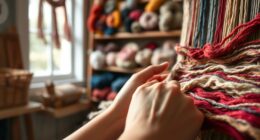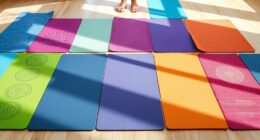In the art world, fiber art and textile art have unique qualities. Fiber art emphasizes traditional methods like stitching and quilting, while textile art incorporates mixed-media elements and deeper conceptual stories. Understanding these distinctions can enhance your appreciation for the creativity and expertise in both areas. If you’re curious to discover more about the differences and parallels between fiber art and textile art, there’s a fascinating journey ready for you to explore.
Key Takeaways
- Fiber art focuses on tactile qualities of fibers, while textile art conveys ideas through material manipulation.
- Fiber art emphasizes sculptural elements, while textile art delves into narratives and conceptual messages.
- Fiber art centers on materiality and dimension, contrasting with textile art's focus on expressing concepts.
- Fiber art emphasizes traditional techniques like stitching, weaving, and quilting, while textile art incorporates mixed-media elements.
- Fiber art and textile art differ in artistic intent: materiality versus conceptual expression.
Terminology Differences
When distinguishing between fiber art and textile art, it's vital to take into account the terminology differences that play a significant role in defining these art forms.
The distinction between the terms 'fiber art' and 'textile art' may seem subtle, but it can impact how the public perceives the work and how the artist identifies themselves within the art world. Fiber art is often associated with traditional techniques like stitching, weaving, and quilting, highlighting the use of pliable, organic materials in creating art.
On the other hand, textile art encompasses a broader scope, incorporating mixed-media and non-organic elements alongside traditional fiber-based methods. By understanding the nuances between these terms, both the artist and the audience can appreciate the rich heritage and innovative approaches that shape the dynamic field of fiber/textile art.
Embracing these differences allows fiber artists to carve out their unique identities and artistic expressions in a continuously evolving landscape.
Artistic Expression Variances
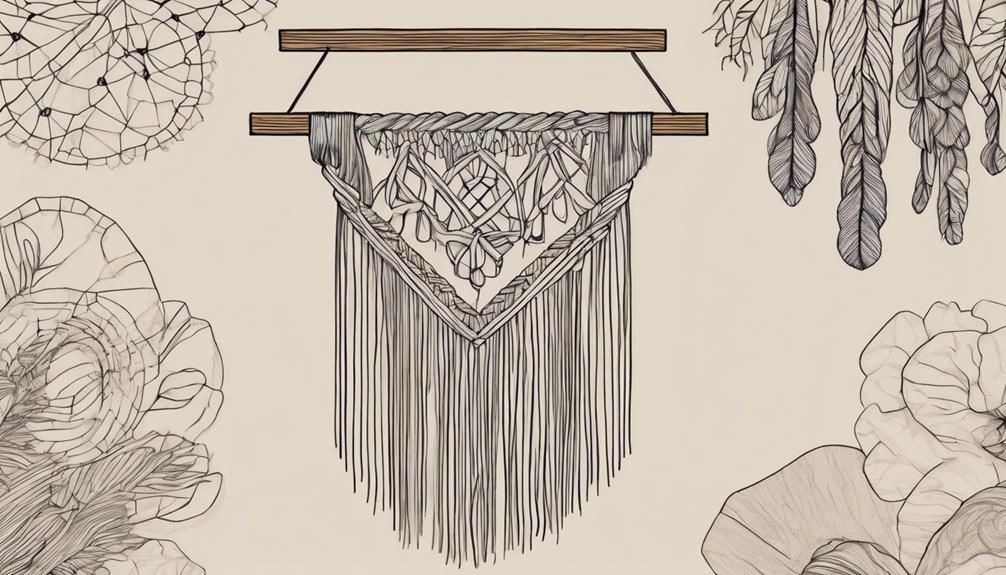
To distinguish between fiber art and textile art, consider the variances in artistic expression that shape how these art forms are perceived and created. In the domain of art, the way artists approach their work greatly influences the final outcome and the message conveyed to the audience.
- Artistic Focus:
Fiber art tends to focus on the tactile and dimensional qualities of fibers, emphasizing the physicality of the materials.
On the other hand, textile art leans towards expressing ideas and concepts through the manipulation of textile materials.
- Emphasis:
Artists in fiber art may prioritize the materiality and physicality of fibers, while textile artists may focus more on conceptual rigor and narrative within their pieces.
- Aesthetic Qualities:
Fiber art pieces often exhibit a more sculptural or tactile quality, engaging the viewer through texture and form.
In contrast, textile art pieces may convey deeper narratives or conceptual messages through the medium.
- Intent and Approach:
The distinction between fiber art and textile art lies in the artistic intent and emphasis on materiality versus conceptual expression.
While both utilize fibers, the primary difference is the approach and intention behind the final artwork.
Broadening Perspectives
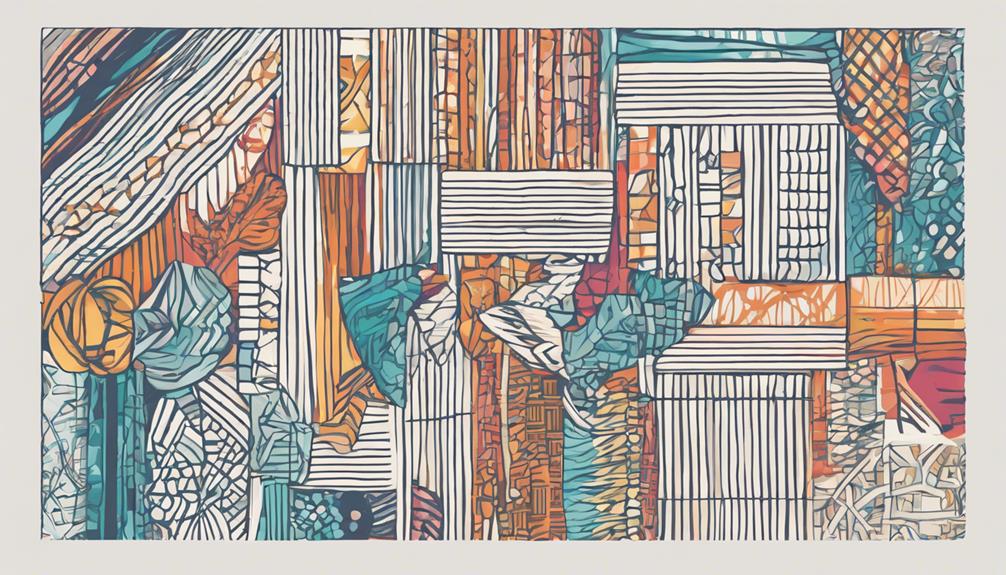
Broadening perspectives on fiber art involves recognizing its dynamic techniques, materials, and artistic expressions.
Fiber art encompasses a wide range of creative practices that go beyond traditional textile art. By exploring the sensory and aesthetic qualities of fiber art, you can gain a deeper appreciation for the intricacies of this medium.
The versatility of fiber art allows artists to push boundaries and experiment with new forms of expression, challenging conventional artistic norms. Embracing the diverse expressions of beauty and ideas within fiber art can contribute to a more inclusive and innovative artistic community.
Engaging with the various mediums used in fiber art not only enhances artistic discourse but also inspires the development of new and unique forms of creative expression. By broadening your perspective on fiber art, you open yourself up to a world of endless possibilities and artistic exploration.
Community Engagement Impact
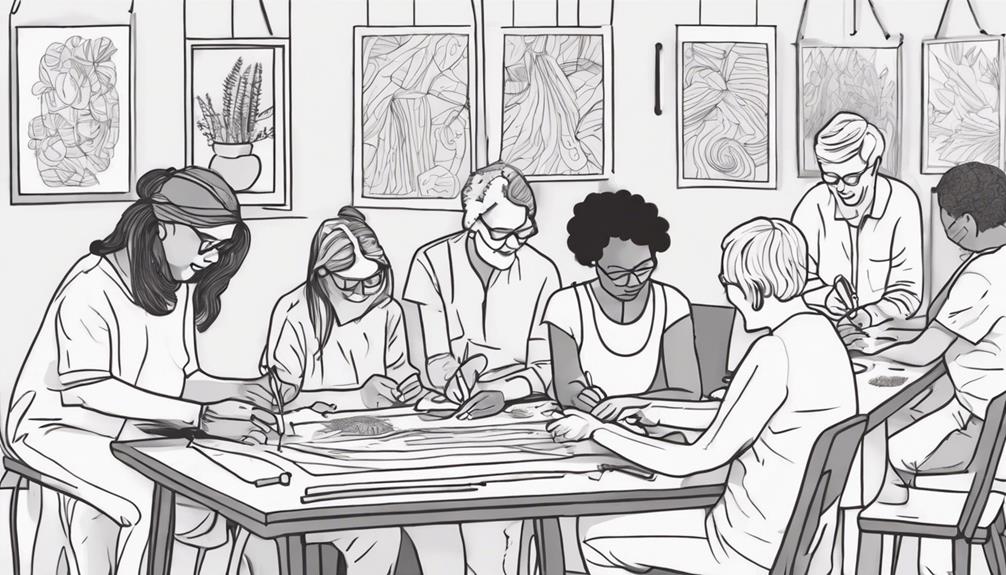
You can analyze the impact of community engagement in fiber art to understand how it fosters connections and creativity.
By overviewing engagement strategies, you can see how collaborating within the fiber art community enhances networking and exposure for artists.
This analysis will shed light on the significance of sharing handmade creations and participating in online platforms to promote visibility and appreciation for the craft.
Community Impact Analysis
Engaging with the fiber art community facilitates connections that spark creativity and collaboration among artists, enthusiasts, and organizations. As you explore the world of fiber art, consider the following impacts of community engagement:
- Support and Appreciation: Sharing your textile art creations within the fiber art community not only garners support but also fosters appreciation for the diverse artistic expressions present.
- Global Reach: Participating in online platforms and events enables fiber artists to showcase their work globally, connecting with like-minded individuals worldwide.
- Exchange of Ideas: Building relationships within the fiber art community opens doors to creativity, learning, and the exchange of innovative ideas that can further enrich your artistic journey.
- Contribution to Growth: Your engagement in the fiber art community goes beyond personal development, contributing to the overall visibility and advancement of this art form.
Embrace the power of community involvement to amplify your impact in the world of textile art.
Engagement Strategies Overview
Connecting with fellow fiber artists and enthusiasts through community engagement initiatives is key to fostering collaboration and support within the fiber art world. By actively participating in community engagement activities, such as sharing your handmade creations, attending events, and engaging with online platforms, you not only showcase your work to a broader audience but also receive valuable feedback and encouragement. These interactions cultivate a sense of belonging and appreciation for the diverse artistic expressions found in fiber art.
Moreover, building relationships with like-minded individuals in the fiber art community can open doors to new opportunities for growth, learning, and artistic development. Supporting your fellow artists and artisans through community engagement initiatives not only strengthens the fiber art ecosystem but also promotes creativity and innovation within the field.
Nestle And Soar Showcase
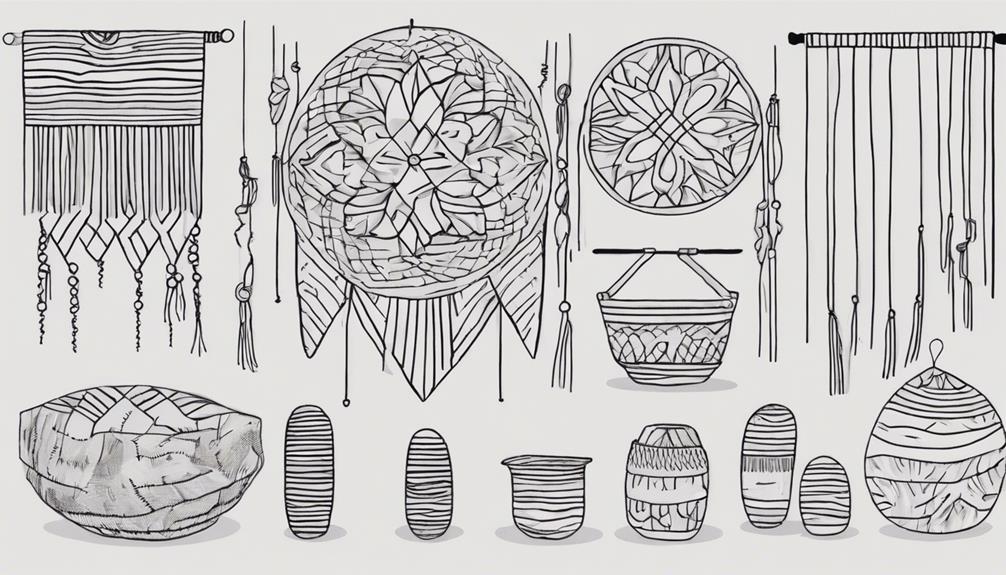
Nestle And Soar presents a stunning showcase of eco-chic fiber art pieces crafted by founder Georgianne Holland. These pieces aren't just art; they're a statement about sustainability and creativity.
Here are some key points when exploring Nestle And Soar's fiber art collection:
- Sustainability: Each fiber art piece is meticulously designed to be eco-friendly, reflecting a commitment to environmental awareness.
- Artistic Vision: Georgianne Holland's artistic vision shines brightly in every creation, showcasing a unique blend of creativity and sustainability.
- Home Decor Enhancement: Nestle And Soar's fiber art pieces are crafted to elevate your home decor, adding a touch of elegance and eco-chic style.
- Circular Discussion Fiber Art for the Wall: Explore the Circular Discussion Fiber Art collection, where each piece tells a story through intricate designs that captivate the eye.
Immerse yourself in the world of eco-chic fiber art by Nestle And Soar, and discover the beauty of sustainable creativity for your home.
Defining Fiber Art Vs. Textiles
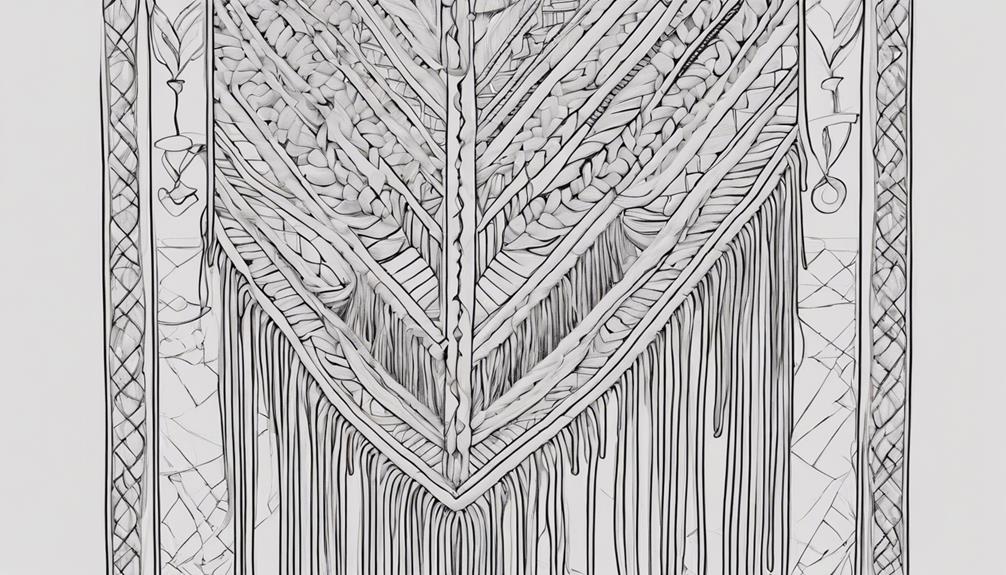
Understanding the distinction between fiber art and textile art is essential for appreciating the diverse techniques and materials employed in these creative disciplines. Fiber art mainly focuses on using pliable, organic materials like fabric and yarn, whereas textile art encompasses a broader range, including mixed-media and non-organic elements.
To provide a clearer picture of the differences between fiber art and textile art, let's examine some key points in the table below:
| Fiber Art | Textile Art |
|---|---|
| Utilizes organic materials like fabric and yarn | Includes a broader range of materials, including mixed-media and non-organic elements |
| Traditionally associated with stitching, weaving, and quilting | Involves a wider variety of techniques beyond traditional fiber art methods |
| Often viewed as emphasizing sculptural and three-dimensional work | Emphasizes the expression of ideas through textile materials |
This table illustrates the nuanced variations in techniques and materials utilized in fiber art versus textile art, underscoring the distinct characteristics of each artistic discipline.
Evolution of Terminology

You'll notice that the terminology in fiber art is evolving to reflect the changing landscape of artistic expression.
Artists are redefining traditional labels to encompass a broader range of materials and techniques.
This shift in terminology highlights the fluidity and innovation present in contemporary art practices.
Terminology Shifts
Amidst the evolving landscape of contemporary art, the terminology within the field of fiber art is undergoing a significant shift towards inclusivity and innovation.
Younger artists are moving away from being defined by a single material, leading to a shift in terminology from 'fiber art' to more inclusive descriptions.
Contemporary work in fiber art is increasingly crossing material boundaries, expanding the term to encompass multimedia creations.
The term 'fiber art' is evolving to embrace a wider range of mediums and techniques, reflecting a more diverse and innovative artistic landscape.
The focus in the art world is shifting towards recognizing the beauty and materials used in art, regardless of traditional labels like 'fiber art' or 'textile art.'
The terminology changes in the field of fiber art highlight a broader movement towards inclusivity and creativity that transcends traditional categorizations.
Artistic Interpretations
How is the evolving terminology in fiber art reflecting the changing landscape of contemporary artistic interpretations? As younger artists break away from traditional material constraints, the terminology surrounding fiber and textile art is adapting to encompass a broader range of artistic expressions. Techniques used are becoming more varied, blurring the lines between what was once considered strictly 'fiber art' and 'textile art.' Artists are now exploring multimedia creations that incorporate fiber alongside other materials, challenging the old definitions. The focus is shifting towards appreciating the beauty of the materials and techniques used, rather than confining artworks to specific labels. The ongoing debate between 'fiber art' and 'art textiles' mirrors the larger conversation about the boundaries within the art world. This evolution in artistic terminology reflects the innovative ways in which emerging artists are engaging with fiber and textiles, shaping the future of contemporary art.
| Evolution of Terminology | Contemporary Artistic Interpretations | Multimedia Creations |
|---|---|---|
| Blurring Material Boundaries | Appreciating Beauty of Materials | Engaging with Various Techniques |
| Shifting Focus | Challenging Traditional Definitions | Exploring Diverse Mediums |
| Recognizing Artistic Innovations | Embracing Artistic Freedom | Pushing Boundaries of Artistic Expression |
| Adapting to New Artistic Practices | Breaking Away from Conventional Labels | Incorporating Multiple Materials |
| Reflecting Changing Artistic Landscape | Broadening Definitions of Fiber and Textile Art | Redefining Artistic Norms |
Materiality Focus
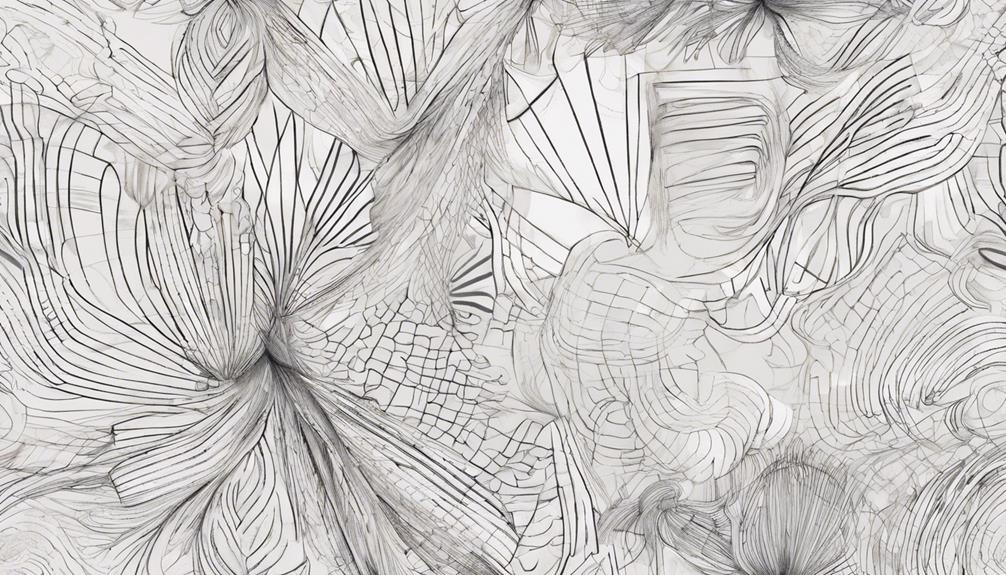
Fiber art places a strong emphasis on the materiality of fibers, highlighting texture and dimensionality in artistic creations. This focus on materiality allows artists to explore the tactile qualities and visual impact of different fibers, enhancing the overall aesthetic of the artwork.
In the domain of fiber art, the choice of fibers is essential in conveying meaning and evoking emotions through the artwork.
When delving into materiality in fiber art, consider these aspects:
- Texture Exploration: Artists experiment with various fibers to create different textures, adding depth and visual interest to their pieces.
- Dimensionality Play: Utilizing fibers in unique ways, artists can play with dimensionality, creating artworks that appear multidimensional and dynamic.
- Fiber Selection Significance: The selection of specific fibers contributes to the overall message and concept behind the artwork, influencing how viewers interpret the piece.
- Tactile Experience: By focusing on materiality, fiber artists aim to engage viewers not only visually but also through a sensory experience, inviting touch and exploration of the artwork.
Fiber Art Vs. Craft Debate
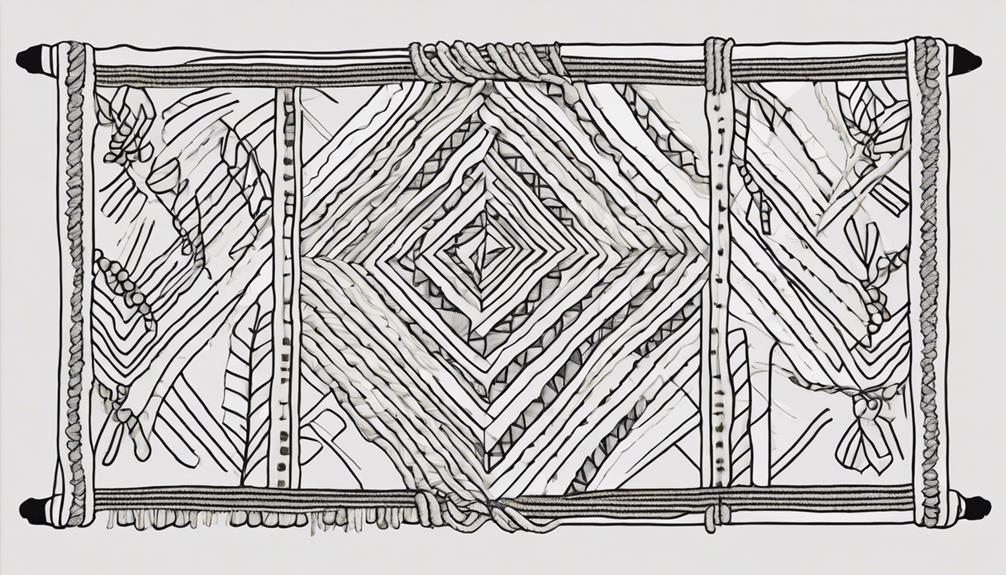
You might be interested in exploring the debate surrounding gender associations in art.
The distinctions between craft and fiber art are also worth considering.
The historical perspectives that have shaped the perception of fiber art are important to examine.
These points shed light on the complexities and nuances within the fiber art vs. craft discussion, highlighting the ongoing evolution of these terms and their significance in the art world.
Understanding these aspects can provide valuable insights into the broader conversation around fiber art's identity and recognition.
Gender Associations in Art
Gender associations in art, particularly within the fiber art vs. craft debate, have historically been intertwined with perceptions of femininity and domesticity. This connection has influenced how these art forms are viewed and valued within the artistic community. When exploring gender associations in art:
- The debate around fiber art vs. craft often immerses into historical gender associations within the art world.
- Terms like 'craft' and 'fiber art' have been linked to perceptions of femininity and domesticity.
- Distinguishing between hobby craft and serious fiber art creation remains a challenge in the art community.
- The term 'fiber art' is still maneuvering gendered connotations, while 'craft' has gained more respectability.
These points highlight the complexities surrounding gender associations in art and the ongoing evolution of how fiber art is perceived in comparison to traditional craft practices. Understanding these nuances is essential for appreciating the diverse artistic expressions within the domain of fiber art.
Craft Vs. Fiber Art
In the ongoing debate between craft and fiber art, distinctions blur due to their historical associations and evolving perceptions. The term 'craft' has traditionally been linked to domestic and utilitarian creations, often undervalued in the art world. On the other hand, 'fiber art' emerged as a term to elevate textile-based creations to the status of fine art.
However, the boundaries between craft and fiber art have become increasingly difficult to define as both terms carry gendered connotations and varied levels of prestige. The challenge lies in differentiating between hobbyist craft practices and serious artistic endeavors within the domain of fiber art.
While 'craft' has faced stigma in the past, it has gained more respect in contemporary discourse. The ongoing discussion surrounding 'fiber art' versus 'craft' reflects the shifting landscape of artistic practices and the continuous reevaluation of what constitutes art.
Historical Perspectives on Fiber
The historical context surrounding the debate between fiber art and craft reveals the enduring impact of gendered associations on these artistic practices. When delving into the historical perspectives on fiber, it becomes evident that the distinction between fine art and craft has been deeply intertwined with societal perceptions of gender roles.
Here are some key points to ponder:
- Terms like 'craft' and 'fiber art' carry gendered connotations, shaping how these art forms have been valued throughout history.
- Distinguishing between hobby craft and serious designer-maker is a challenge within the domain of fiber art, reflecting the broader debate on the hierarchy of artistic practices.
- The term 'craft' has historically held less prestige compared to 'fine art,' underscoring the shifting perceptions and evolving definitions within the art world.
- The term 'fiber art' continues to grapple with gender associations, influencing the reception and recognition of artists working in this medium.
Resurgence and Future Trends
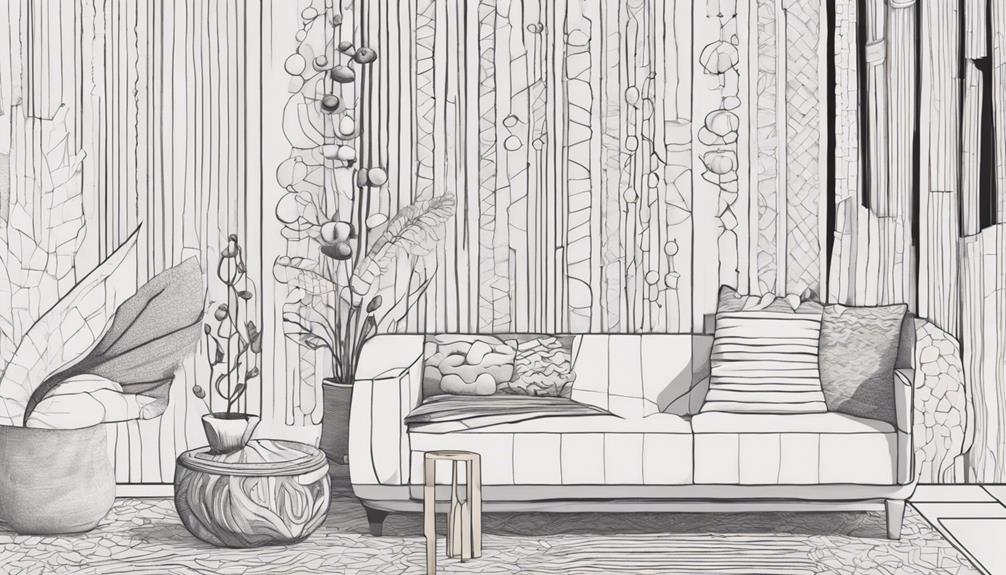
Amidst the academic landscape, the term 'fibre' is experiencing a revival as institutions like the Winchester School of Art reintroduce it to their programs, sparking discussions on the legacy and future directions of fiber art. This resurgence of interest in fiber art isn't merely about a return to traditional practices but signifies a shift towards innovative and interdisciplinary approaches.
By adding 'fibre' to course titles, institutions are aiming to provoke conversations on the distinctiveness of fiber art from commercial production, emphasizing materiality and creative techniques.
Younger artists are at the forefront of shaping the future trends of fiber art by exploring diverse media and reimagining the boundaries of fiber and textiles. Their experimentation with traditional techniques alongside contemporary practices is redefining the landscape of fiber art.
This renewed interest in fiber art showcases a growing appreciation for the craftsmanship and artistry involved in working with fibers, pointing towards a future where the boundaries between textile and fiber art blur in exciting and unexpected ways.
Frequently Asked Questions
What Is Another Name for Fiber Art?
Another name for fiber art is textile art. It's a common term used in the art world to describe creating art using pliable materials like fabric and yarn.
While the naming preference may vary between countries with 'fiber art' in America and 'textile art' in Britain, both terms encompass a wide range of artistic practices.
Whether you say fiber art or textile art, the essence remains the same: expressing creativity through fibers and textiles.
What Is Textile Art Also Known As?
Textile art, also known as fabric art or cloth art, involves a diverse range of techniques using various fibers. Artists create stunning pieces through processes like weaving, knitting, embroidery, and quilting.
Materials such as cotton, silk, wool, and synthetics are used to craft these intricate pieces. Throughout history, textile art has served as a powerful means of artistic expression and cultural storytelling.
What Is Considered Fibre Art?
Fiber art encompasses art pieces made using pliable materials like fabric, yarn, and thread. Techniques such as stitching, weaving, and quilting are common in this form of art.
It often includes mixed-media elements and non-organic materials for artistic expression. The focus is on tactile and visual qualities, showcasing creativity and innovation.
The term 'fiber art' is often used interchangeably with 'textile art' to describe art created using fibers.
What Are the Two Classifications of Fiber Art?
When exploring fiber art, understanding the two main classifications is crucial: traditional and contemporary fiber art. Traditional fiber art relies on ancient techniques and materials such as fabric and yarn, while contemporary fiber art pushes boundaries with mixed media and innovative approaches.
Conclusion
So, now that you know the truth about fiber art and textile art, you can appreciate the unique differences and similarities between the two.
Whether you're a creator, collector, or simply an admirer, understanding the nuances of these art forms can deepen your appreciation and connection to the world of textiles.
Embrace the beauty and creativity that both fiber and textile art have to offer, and let your emotions be stirred by their unique expressions.

